A Musical Journey
 Steven Landsberg playing the Sitar
Steven Landsberg playing the SitarThat I would engage and persist in the learning and practicing of Indian Classical Music for the last thirty years is somewhat astounding, even to myself, considering that I had no family background in music at all. While I was on my way to India in l967, studying Indian music was only a secondary consideration that was not to extend beyond my proposed stay of one year. Sanskrit, philosophy, and religion were to be my main focus of attention; and if I had time, I was going to join the Music College at Benaras Hindu University and peripherally attend to tuning my voice.
My plans changed rapidly as I moved from an interest in vocal music to flute and finally onto sitar. Sanskrit did continue, while my interest in philosophy and religion took on a more practical focus outside the university boundary. Varanasi was a vibrant city, a fountain of spirituality, and certainly a romantic fantasy for anyone who had spent the first seventeen years of life either at home or in some classroom in the United States.
The cultural centers of India in the sixties were still filled with a charming group of people from generations born well before independence; and the older musicians of that time maintained the residual fragrance of the India that cherished knowledge beyond wealth and status.
Ustad Mushtaq Ali Khan was clearly an 'old world' master and I had the good fortune to meet him sometime in l968. He was living in his ancestral home in Varanasi, the same home that had been gifted to his great grandfather by Jahandar Shah, the eldest son of the last Mughal emperor Bahadur Shah.
When I met Mushtaq Ali Khan, I had been studying Indian music for about a year and I was more filled with ambitious questions than with actual practice, condition beginners in every practical field must suffer.
Although Khansaheb was a highly respected musician, he behaved without pretense. His hospitality was warm and inviting; and he made everyone feel comfortable in his presence. He was happy to hear that I had taken interest in Indian music; yet he was circumspect as to why a "foreigner" could abandon the comfort of the West for the study of this traditional music.
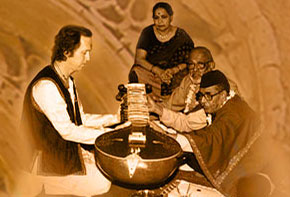 Mushtaq Ali Khan places the Surbahar into my hands, the traditional method of introducing the student to the instrument before actual training is begun. D.T. Joshi and Ustadji's wife witnesses the occasion.
Mushtaq Ali Khan places the Surbahar into my hands, the traditional method of introducing the student to the instrument before actual training is begun. D.T. Joshi and Ustadji's wife witnesses the occasion. Actually, my initial experiences of listening to Indian music had drawn me toward its powerful emotive presence. I had no idea of what I was listening to, but a collage of emotions seemed to arise spontaneously from the notes and the melodic matrices they formed. I think it was this intimate relationship between tonality and its inherent emotional content that inspired me to look deeper into Indian music and the sitar. It was to take years of study to comprehend what these feelings were all about.
I continued to frequent Mushtaq Ali Khan through the late sixties and early seventies. I had several opportunities to hear him play both sitar and Surbahar. What impressed me at that time about his playing was the beauty and clarity of his hand, his tunefulness, and his clear exposition of the raga. He seemed so at ease with the instrument, unlike many other players who looked as if they were at war with the instrument and the music. His left hand moved over the fret board without resistance as if he were carving a curved line through space. His right hand was powerful; yet his finger moved with incredible flexibility and ease. It took me years of practice to understand how he could display such unstrained intensity and maintain complete relaxation.
Although I was really impressed by his poise and his effortless control over the instrument and the music, I did not ask him to teach me. At that time I did not feel ready to learn in the traditional guru-disciple method that had been the traditional way of communicating knowledge for thousands of years. This process of engagement assumed a level of commitment from both teacher and student. I was still very much consumed by my own fantasies about the music and wanted to make up my own path rather than submit to the tradition of knowledge that Mushtaq Ali Khan had so completely assimilated. By l973 I had grown tired of my fantasy. I had reached a dead end with my practice and realized that unless I was willing to make a serious commitment, there was no reason to continue. I then decided to engage in this traditional relationship with Mushtaq Ali Khan and to this day I am indebted to him for whatever I have understood about Indian music.
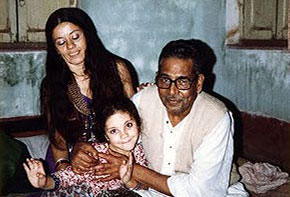 Ustad Mushtaq Ali Khan enjoying an affectionate moment with my wife and daughter.
Ustad Mushtaq Ali Khan enjoying an affectionate moment with my wife and daughter.Mushtaq Ali Khan, in fact, had never taught anyone to play Surbahar. He had many sitar students and a few of them had become very fine artists. Nirmal Guha Thakurta and Netai Bose had learned from him since the l940's and both of them were very accomplished sitarists when I started learning.
Ustadji was a traditional artist and teacher. He taught systematically and did not give lessons beyond the scope of a student's ability. I thought I was a rather serious student; and although I was eager to learn more than I was getting, Ustadji seemed to be rationing his musical treasure. I was not sure if this was a method of teaching or just a way to curb my zealous appetite. Mushtaq Ali Khan gave a lot of attention to detail and the fundamentals of technique and did not want his students to become absorbed prematurely in the vast sea of material that made up an artist's repertoire. Gradually, I adjusted to his style of teaching. I began to recognize that although the amount of material was spoon-sized, the practice necessary to digest it was without end.
I remember once going to Khansaheb's house to demonstrate a lesson I had been practicing for one month. I played it before him and noticed that he was particularly disturbed by my demonstration. Shortly thereafter, he came out of his room and gave me a handful of hundred rupee notes. He told me that he was returning the money I had given him for my lessons and that he was no longer going to teach me. There was no further explanation except that my sincerity as a student was in question. I was astonished and had difficulty understanding what this was all about. His wife and nephew urged me to explain to him how badly I felt about this situation, request his forgiveness, and promise to be more diligent in the future. I followed their advice and demonstrated my heartfelt regret. Things eventually cooled down and my lessons resumed. What Ustadji saw in my demonstration was that I had overlooked many details in the traditional composition he had given me and instead had just tried to play it as fast as I could. Mushtaq Ali Khan did not like to see his treasures misused in any way and was ready to sacrifice whatever it was to preserve the integrity of his musical domain. I was careful after that experience not to abuse what he was showing me.
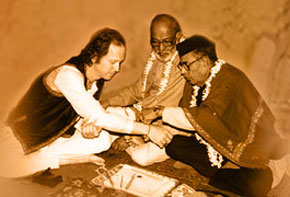 Ustad Mushtaq Ali Khan ties the traditional thread (gandha) which binds the relationship between master and student. The renowned D.T. Joshi, disciple of Enayet Khan, looks on
Ustad Mushtaq Ali Khan ties the traditional thread (gandha) which binds the relationship between master and student. The renowned D.T. Joshi, disciple of Enayet Khan, looks onWhen I questioned Ustadji about Indian music and its relation to yoga and sadhana, he gave me an answer that I have thought about continuously for many years. He explained that when a musical sound coemerges with aesthetic appreciation and the necessary hand technique to produce the sound, music as a sadhana becomes more than just a fanciful idea. Considering that sadhana always functions with body, speech, and mind; the perfectly formed hand movements are the body's mudra. The arising of the musical idea as meaningful sound is the musician's form of speech. The awareness and aesthetic appreciation of the raga's inner face as a continuous presence is the musician's mind. All three aspects working simultaneously are musical sadhana. Although it may take one's lifetime to have some practical comprehension of this concept, music as a vehicle or path towards genuine fulfillment is only possible when there is this function of body, speech, and mind.
Ustadji was a complex man with many moods. At times he could be extremely generous with his knowledge; and on other occasions he could be very reserved and unwilling to say a word. I saw people ask questions that he would totally ignore or just remark, "Why do you want to know that? There is no need for you to know anything about that." I became accustomed to his moods and knew when it was appropriate to ask questions and when not to even open my mouth.
After several years of learning and practice, Khansaheb invited me to stay with him at his house in Varanasi. Traditionally, it was common in India for students to live with their teachers. The regular contact facilitated learning and provided an enriching environment in which dedicated students could mature and have the opportunity to serve their masters.
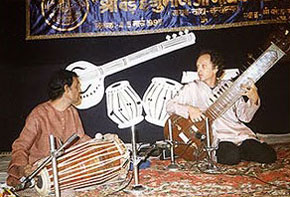 Performing the tarapan with a pakhawaj player at Varanasi music conference in 1994
Performing the tarapan with a pakhawaj player at Varanasi music conference in 1994By l985 I had become so absorbed in my sitar practice that I pretty much forgot about learning Surbahar. While visiting Calcutta that year, Ustadji said to me that I should not ignore the Surbahar. I did not know what he really meant and I cannot honestly say that I heeded his words. In l986 I remember giving a sitar performance based on some lessons he had given me. I sent him a tape of that performance and I think that he must have liked it; because when I called him in early l987, he took the phone and told me he was going to teach me Surbahar. This was very unusual as he never told anybody in advance what he was going to teach; and , furthermore, he had never taught this instrument to anyone. He must have felt my disbelief while talking to me because he mentioned that his nephew Ishtiaq Ali was present witnessing his words. There were several other students who wanted to learn; but for reasons beyond my understanding, he thought I should be the sole recipient of this part of his musical heritage.
I went back to India that winter and after making me a thread-bound disciple and placing the Surbahar in my hands as is the necessary gesture dictated by tradition, he began to show me the unique methods of the Surbahar. I returned to India the following year and Ustadji, in the last lessons he was to give me before his demise, showed me the method of Tarparan.
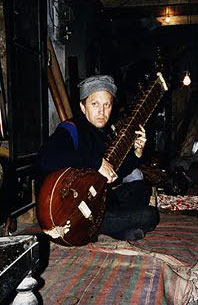 In the music shop of Kanailal and Brother, I practice informally on the Surbahar.
In the music shop of Kanailal and Brother, I practice informally on the Surbahar.Since his death I have received some training from the great dhrupad vocalist Fahimuddin Dagar. Nirmal Guha Thakurta and Netai Bose, Ustadji's senior disciples, have generously shared with me their insight into the Senia tradition of sitar. Mr. Thakurta has been especially helpful in correcting many compositions I learned and has taught me numerous compositions created by Ustadji and his predecessors.
It has only been in the years after Mushtaq Ali Khan's death that my playing of both the sitar and Surbahar really matured to a performance level. I have traveled to India, Nepal and Bangladesh in the last 10 years and have given numerous demonstrations of both sitar and Surbahar.
After the millenium I moved to Kathmandu and taught sitar at Kathmandu University for three years. While I was living there, I had the opportunity to give many live performances and meet local Nepalis also dedicated to the study of classical Indian music.
I then moved to Latin America where I lived for 8 years on a small island in the southern caribbean. It was difficult to find any Indian percussionists there but I did find some excellent drummers who I trained to accompany traditional Indian music. I moved around continuously there and had the chance to perform in Buenos Aries, Lima, Mexico City and Isla Margarita.
Currently, I am living in New York City where I will continue to teach and play.